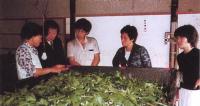Sericulture
A series of experiments on silkworm raising was begun in 1984 in Matsumoto, Nagano Prefecture. A part of the mulberry field owned by a local church member has been set aside to raise mulberry trees according to the principles of nature farming. Prof. Toshio Ohnishi of the Kyoto Institute of Technology supervises this research project.

|
|
Silkworms feeding on mulberry leaves, silkworm nursery, Matsumoto.
|
Findings to date indicate that:
- Silkworms prefer pure, uncontaminated mulberry leaves;
- Non-manured leaves are digested more easily;
- Silkworms fed non-manured leaves have a lower rate of disease incidence and stronger resistance to viruses;
- Silkworms given Johrei prior to injection of viruses have a higher rate of survival;
- Silkworms reared on unfertilized leaves produce silk fiber of better quality.
(See Mitsuo Kuwada and Toshio Ohnishi, "Sericulture with Unfertilized Mulberry Leaves," Appendix I of Miracles of Healing.)
Prof. Ohnishi presented a report on this study at the 1988 regional conference of the Japan Sericultural Research Association. The following year Rev. Mitsuo Kuwada of Reimei Church, Prof. Ohnishi's collaborator, delivered a paper on the quality of silk fiber from the uncontaminated cocoons at the association's annual meeting.
12/16/1997 Reimei Church (revised on 04/05/98)

